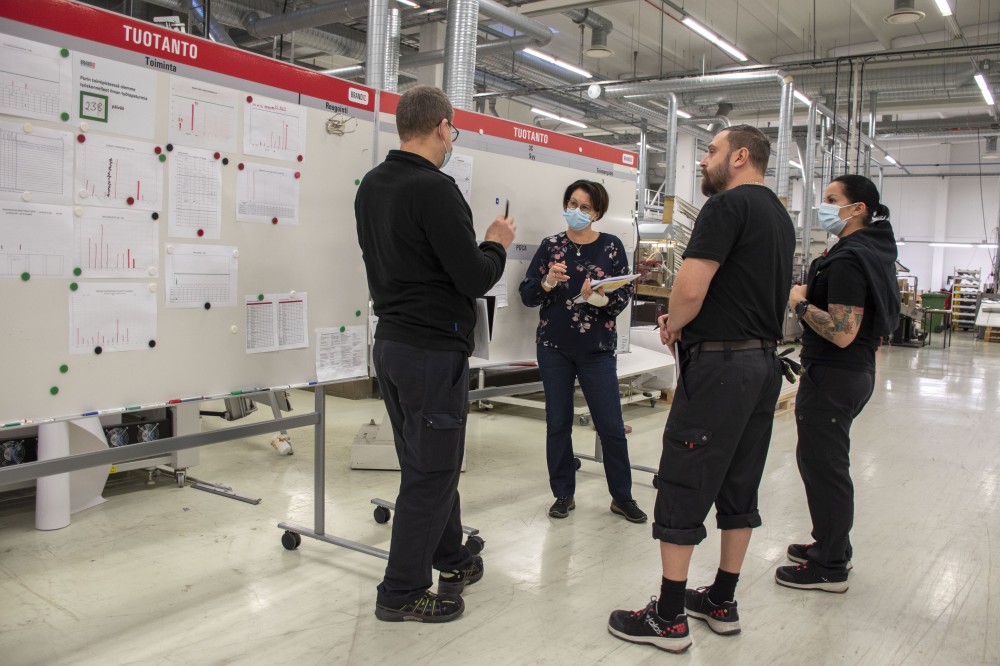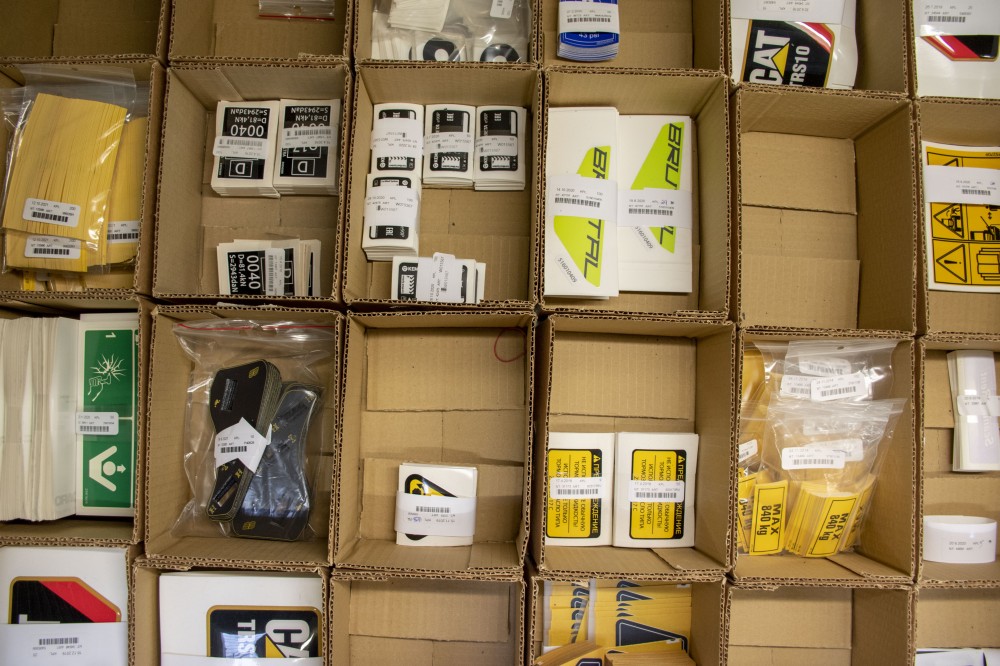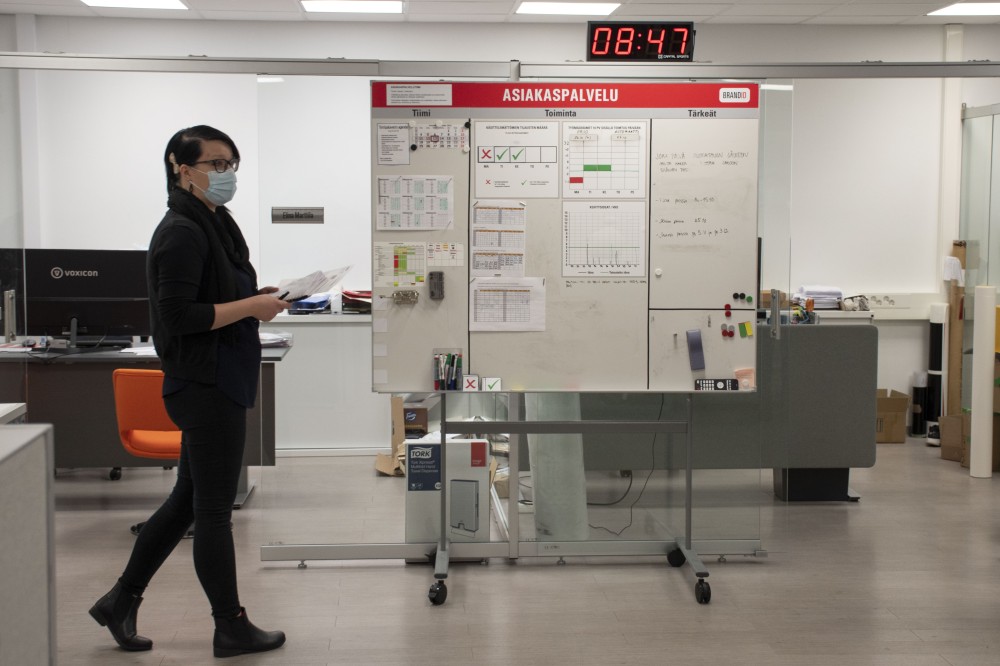How KAIZEN™ became a crucial part of developing Brand ID in Finland to the next level
“KAIZEN™ is a very powerful way of developing and leading your company. It blooms our business today, and without KAIZEN™ we would not be here where we are today.” That’s a strong statement by Juha Heljakka, Owner and Managing Director of Brand ID, based in Pori, Finland. Brand ID continues to rapidly develop and improve its performance a few years after its KAIZEN™ implementation. In this article, Juha Heljakka discusses with Robin Cox, Kaizen Institute, Ltd., why no company should hesitate to start with full power, providing insights into how Brand ID’s ongoing KAIZEN™ journey has become a sustainable success.
Company profile:
Brand ID specializes in printing solutions and is the largest manufacturer of industrial markings – such as decals, packaging, and branding products – in Scandinavia. The history of the company started in 1967 by producing board games in Finland. Over the years, Brand ID began to specialize in industrial graphics and retail store brand concepts and decided to split from its parent company, Nelostuote. Nowadays, Brand ID has many international customers operating in a wide range of industry sectors. Brand ID Oy was acquired by the management in 2016. In 2018, Brand ID Oy acquired the business of Pirkan Pakkaus Oy and Printcenter Oy, increasing its product portfolio with display and packaging products. In spring 2019, the company’s display and packaging branch changed its name to Brand ID Display & Packaging Oy, and today, Brand ID is a group of four companies that serves customers in all types of branding projects. The company delivers worldwide to 35 different countries.
What was the starting point for your company – and how did you get so engaged in the entire transformation?
We got interested in KAIZEN™ when we heard of its power in managing a whole company, showing a direction with strategy and concrete steps for how to develop, and how to get the entire business to the next level. Especially for the board of directors, it’s very important that they have tools available for how to manage people, actions, processes and the whole business. It has helped us to communicate and understand our targets, and it gives us a language to speak with everybody in the company and in the business. No matter who we are talking to in our company, it really is like we have an agreement on doing things in a simpler way. So, KAIZEN™ is also our language in this company. I really get a lot of positive feedback about the visual system, how we present things with the help of KAIZEN™. It’s like a core in our business today that we show, we present, all things and the communication in such a way that it’s simple and very easy to understand.
“It’s like a core in our business today that we communicate in such a way that it’s simple and very easy to understand.”
The first thing we learned with KAIZEN™ is: don’t hesitate to start with full power. The more we developed with the KAIZEN™ way, the more we understood that we’re not using it as much as we should. We started little by little, then we increased the usage and help of KAIZEN™. Now it’s a crucial part of our business system in all our operations and all our locations.
What aspects of KAIZEN™ are most important for your company?
Companies are typically very good at making strategies but executing a strategy into actions is much more difficult. Especially, how can we lead and manage our company and communicate with our people in such a way that we can say that this is coming from our strategy? When we act, when we are developing processes and trying to get to the next level, we always ask ourselves the following question: What we are doing today, is it really getting us where we are heading with our strategy? It’s very important that we have this string coming from the strategy because it allows us to initiate actions and to look back to where we came from.
It’s important that we have divided our targets into such simple steps that we can follow them on a monthly basis. This way, we can always communicate with our teams and check whether we are hitting the target. Are we on the right course? For example, if we want to sail from Spain to the Caribbean, we use a compass. Then we get winds and water taking us in other directions – so we need to adjust the direction to make sure that we are hitting the right island on the other side of the Atlantic Ocean. The same happens to businesses.

An important principle of KAIZEN™ is to make strategy implementation look very simple: you get the targets from the strategy, you break these down to actions on a process level, and then you are constantly measuring what you have, for example, achieved on a daily basis. Are we reaching the right goal with the help of KAIZEN™ on a daily basis with ongoing Continuous Improvement? That leads us to say that KAIZEN™ is our strategy to develop our business and our processes. It’s a methodology for managing the company and the business, it’s a methodology to develop our strategy, it’s a methodology to execute our strategy, and that’s very important. You can see that in the production, in the sales team, in the customer service team, what we are really doing is coming from our strategy. Is what we are doing at our core? Is it what we really want to do? And that is what KAIZEN™ is all about.
“KAIZEN™ is our strategy to develop our business and our processes. It’s a methodology for managing the entire business and it’s a methodology to execute on our strategy, and that’s very important.”
Brand ID’s KAIZEN™ principles
1 I create value for customers
I know who my customer is and what kind of value my customer expects. I am responsible for the customer.
2 I eliminate waste from the value chain
I am able to create more value for the customer when I improve the process by identifying and eliminating non-value-adding activities.
3 I know where the value for the customer is created
I improve operations by focusing on the Gemba – the place where value is created. By changing Gemba, I can influence the value in the chain.
4 I contribute to improvement
I have an opportunity and obligation to improve every day.
5 I comply with the agreed procedures and react quickly to deviations
My actions are based on agreed best standards. Deviations from agreed procedures require immediate corrective action. I am responsible to react.
What are the biggest changes you have seen in your business and way of working?
Beyond the strengths that I see in strategy implementation, KAIZEN™ has become so powerful that it is also a key part of our way to achieving growth. For us, KAIZEN™ plays a very important role when we are making acquisitions and looking for businesses that have the potential to support the growth strategy we have at the moment. We have experienced that by implementing our system of management, we can realize the potential of the new company very fast – much faster than we would normally do. So, right from the start, we put KAIZEN™ in place in a new organization as we did some months ago. And the feedback from the company that we acquired, was tremendously positive. The directors say that now we have a very straight and simple direction, we know what to do, we have tools to lead and to communicate and we already see very positive results after a very short period of time. With the new company, we started by establishing KCM – measured by the KAIZEN™ Change Model percentage. This provides us with a score that shows how much of the expected change capabilities we already have in place. We gave ourselves a target of where we wanted to stand at the end of the year, for example. It shows me: We get figures, we get targets, and we get results.
What is the most beneficial thing that you have learned about KAIZEN™?
For me, the biggest value of KAIZEN™ is that it helps me develop, manage and lead the company, and communicate with people. It’s like we have a new language in our company. I asked my board of directors after we started doing KAIZEN™ how they liked it. None of them would like to go back to the previous system that we used, or the previous way we used to work. It’s a principle. It’s not giving you the content for your business, but it gives you the tools. I compare it with building a house: You may have the wrong tools – but with KAIZEN™ you get exactly the right toolset to build your house. This aspect is very crucial.

What cultural changes have you observed in your company?
We all have heard that culture eats strategy for breakfast. Concerning culture, I would like to give you an example. When you have a good way of doing the strategy with the directors and with your organization overall, this influences culture. You start to speak the same language, you start to think the same way. What KAIZEN™ has brought to us is a new way of thinking. That is one of the most important results that KAIZEN™ triggers people to start to think in a different way. They see the results of their actions, and they have instruments to reflect on them: What are our targets, what is our mission, what is our vision, and why do we do this? It starts by asking different questions, and then the culture follows.
We started by doing workshops. It’s very important that everybody attends these workshops. It’s not only top management, it’s not only a certain team. KAIZEN™ is a very nice way to get everyone together to work on the targets and the job that we need to get done together.
If I would give a score to KAIZEN™, I would estimate that 30 percent is about the tools and establishing a standard way of doing and managing the company, with meetings and so on. Another 30 percent is about the visual elements that we can show and use to communicate with people. And the remaining part is about culture. In total, KAIZEN™ is more on the people side than on the tool side. This touches the culture in a very positive way.
“We learned that our people started to change the culture because they think differently. They see the results of their actions and reflect on them – What are our targets? And why do we do specific things?”
The Brand ID Management Model
Brand ID developed its management model based on KAIZEN™. The model has been gradually implemented in day-to-day operations. Visual and factual management is one part of the game. Measures and indicators for strategy implementation are defined in the strategy room – with one of the indicators being the number of improvement proposals implemented by the company’s employees. The number of ideas has continuously increased, and their realization has accelerated. The development of operations is, for example, reflected in the quality and delivery reliability.
The development is tracked in various ways: Value chain Lead Times are shorter, and the number of pending deliveries is reduced. Things are done faster, and flexibility is improving. Employees involved in implementing the change are also more motivated. In one recent value chain project, the Lead Time from customer order to delivery was reduced by 60 percent.
What are your future plans with KAIZEN™?
Our future plan is to grow and use KAIZEN™ as a strategic methodology at the core of our business system. We are growing and conquering Scandinavia more and more, so the future looks very promising. In general, we have become much more confident because of KAIZEN™: We know what we can do with that!

Also, KAIZEN™ heavily supports us in finding new approaches to ESG – Environment, Social and Governance – issues. We think that we are an environmentally sound company. We have had our environmental systems in place since 2004, we are certified according to ISO 14,001. And still, we see that there are a lot of things to do. As a family business, we need to think long-term. I always say that ‘our quarter takes ’25 years’. KAIZEN™ helps us to have this long-term perspective on sustainability and to improve step by step based on continuous improvement.
What advice can you offer others who are considering a KAIZEN™ journey?
Before, we thought that our way of doing business and managing the company was pretty good. We saw some good results and growth. But if you want to be a leader in your segment, you have to be a little bit better.
For those who are hesitating, I recommend to read the Harvard Business Review article about Danaher and its business system. This company has grown successfully all by doing the KAIZEN™ Business System and using KAIZEN™ principles. Considering this: The only thing I can suggest is don’t be afraid of implementing KAIZEN™ to get this additional edge. But don’t start from production, start from sales and management. Then you will get more results in a shorter period of time.
KAIZEN™ is not a one-trick pony. The power of KAIZEN™ is that it comes from the owners and comes from the strategy. It’s about how to lead the company, how to develop and lead the projects and how to communicate the strategy to the organization. It’s not only for production, not only for marketing. It contains everything you need in your business. And that’s the power of KAIZEN™.
“KAIZEN™ is not a one-trick pony. The power of KAIZEN™ is that it comes from the owners and from the strategy. It contains everything you need in your business.”
